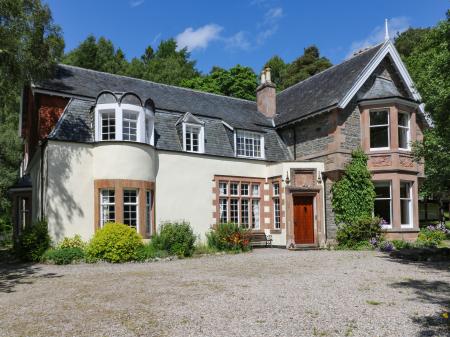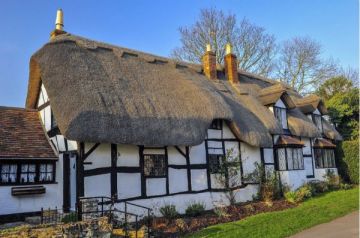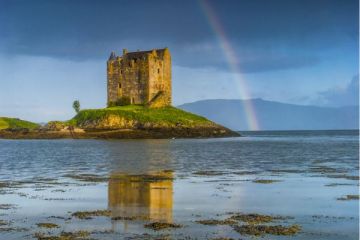In this series, I've been looking at some of the most beautiful places in Scotland, from historic cities like Edinburgh to remote islands like Colonsay, from the Highlands to Orkney. Along the way I'll be sharing some of my favourite photos from over 15 years of exploring Scotland.
The Isle of Mull doesn't get the attention it deserves. Mull, along with its neighbour Iona, draws far fewer visitors than [equally beautiful] islands like Skye. Of course, it doesn't have a bridge to the mainland like Skye, but even so, Mull deserves far more visitors than it gets.
Of those visitors that do visit Mull, many are in a hurry to reach Iona, that tiny island just off the western tip of the Ross of Mull that has been a magnet for visitors since it was settled by monks from Ireland under St Columba sometime around AD 563. Iona is well worth a visit (or two, or three) but don't forget about the rest of Mull. Some highlights that we enjoyed on Mull and Iona include these wonderful places:

A magnet for hikers, Ben More is the highest mountain on Mull and the highest in the Inner Hebrides outside Skye. There are several popular routes to tackle the ascent of Ben More. The most frequently used trail starts at Dhiseig. Just be aware that deer stalking can take place here between late August and October so it is good to check ahead.
You can enjoy the beauty of Ben More without breaking sweat; there are fantastic views of the peak from the shore near Pennyghael, on the Ross of Mull.
There are numerous places to pull off the A849 along the shore of Loch Scridain and you can walk out onto the low-lying grassland between the road and the loch and get some amazing views north to the mountain peak.

From Pennyghael a minor road leads across the neck of the Ross of Mull along Glen Leidle to Carsaig where you can park overlooking a small sandy beach.
From Carsaig a trail leads west along the rocky shore to the Carsaig Arches, a natural rock formation like a free-standing archway. The going is a bit rough in places, but my 12-year-old son made the 4-mile walk to the Arches without trouble, so if you are reasonably fit you should have no trouble.
About 1/3 of the way to Carsaig Arches you will see Nun's Pass, where a waterfall tumbles down the cliff face. A precipitous trail leads up the Pass, and beside the trail is the Nun's Cave, named after a group of nuns who are thought to have sheltered here after they were driven off Iona by religious zealots at the time of the Reformation. The cave interior is carved with crosses dating from the 6th-9th centuries.

If you continue west from Pennyghael instead of turning south to Carsaig you will come to the pretty harbour at Bunessan, the largest settlement on the Ross of Mull. Here you will find the Ross of Mull Historical Centre, run by local volunteers aiming to preserve the rich heritage of the Ross of Mull. Bunessan is a wonderful place to see sunsets; either from the harbour itself or from the shore by Eorabus, just north-east of the village.

A minor road heads south from Bunessan to a parking area at Ardalanish. If you follow the straightforward trail from the parking area you come to Ardalanish Bay, a pristine expanse of white sand facing south towards Colonsay in the distance.
This is one of the most beautiful and secluded beaches on Mull and well worth a visit. I enjoyed an early-morning outing to Ardalanish and had fun photographing bird tracks across the clean, white sand.

If you head west from Bunessan you will come to Fionnphort at the very tip of the peninsula. Here is yet another beautiful beach, this time facing west across the Sound of Lona to the island of Iona. We enjoyed staying in a holiday cottage for a week at Fionnphort and it was a delight to look out the window and see Iona across the strait.
There are regular ferry crossings between Fionnphort and Iona, and the crossing takes only a few minutes. Iona is one of the most historic and scenic places in Scotland, a burial place of ancient saints and as many as 60 kings. Every step you take is following in the footsteps of thousands upon thousands of pilgrims who have come to Iona seeking spiritual peace for over 1300 years.

At the heart of Iona, of course, is Iona Abbey. The history of Iona Abbey could fill volumes, but for photographers there is one major attraction; the restored cloister walk with its beautifully symmetrical double columns lining a quiet square outside the abbey church. Attached to the church is St Columba's shrine, and outside the church stands St Martin's Cross, made between 750 and 800 and still standing on its original site.
To really appreciate the beauty of the island I highly recommend a boat trip around Iona. Our family took a sailboat tour leaving from the dock at Baile Mor, the main entry point for visitors to the island. Our voyage took us around the northern tip of Iona and down the west shore before returning, and on the way we got unparalleled views of the island and its breathtakingly beautiful coastline and quiet beaches.

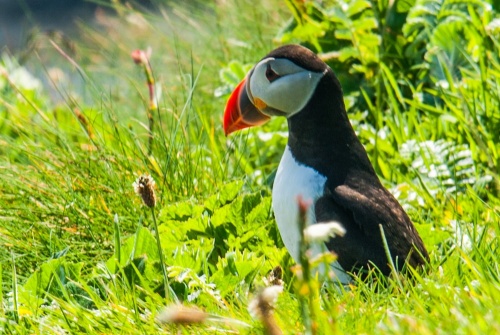
Though not technically part of Mull and Iona, I'll add Staffa to our list because most people coming to the island will arrive on a tour boat from Mull. Most boats leave from Fionnphort and are weather-dependant. It is always a good idea to book ahead, but even then I advise having a 'Plan B' in mind for the day in case the weather is too rough to allow tour boats to make the trip.
There are two main reasons to visit Staffa. One is the bird-life. Staffa is home to a wide variety of seabirds but is most popular with visitors for its resident puffin colony. You can often spot puffins emerging from their burrows on the north-east coast of Staffa and it is well worth taking binoculars or a camera with a telephoto lens to get a good look at the puffins.
The other main reason to visit Staffa is to explore Fingal's Cave, a huge cave on the south coast of the island. The cave is made from hexagonal basalt columns, similar to the famous Giant's Causeway in Northern Ireland. Fingal's Cave has drawn visitors for centuries, among them composer Felix Mendelsohn, who was inspired to write his Hebridean Overture.
From the boat landing, a trail leads around the south-eastern tip of the island to the cave. You can walk well inside the cave and experience the astonishing acoustical qualities of the cave chamber.

Travelling east along the Ross of Mull in the direction of Craignure you come to Glen More. If you leave the A849 near Ardura and follow the minor road south along Loch Scridain you come to a secluded loch known as Loch Uisg. The inland loch is bounded by forest on all sides, making it an incredibly peaceful place to stop and walk along the shore. But better is to come; keep going west along the road until you reach a parking area at Lochbuie.
From there a trail leads along the shore to the ruins of Moy Castle, a 15th-century tower house, and beyond to an isolated stone circle. The views along the shore at Lochbuie are simply stunning, with amazing vistas towards the peak of Beinn nan Gobhar.

So far all our scenic highlights on Mull have been in the south of the island. If you take the B8073 up the north-western side of Mull in the direction of Ballygown you come to Eas For, a dramatic waterfall that plunges over a sheer cliff to the rocky shore below.
If you have a head for heights you can creep right to the edge of the cliffs and look straight down over the falls (it is nerve-wracking!) but if you want to play it safer you can follow a very easy path to the shore and get amazing views of Eas For from the base of the waterfall.
The last time we visited I met a chap at the base of the falls taking a photo using a homemade pinhole camera. He assured me the result would be amazing, and I believe him; it would be hard not to take an amazing photo of Eas For!
If you don't fancy even taking the trail down to the shore there is also a lovely little waterfall above the road, very easily reached.
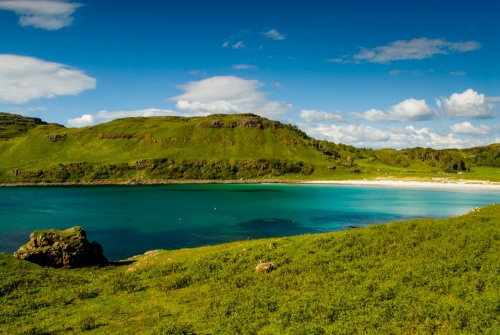
If you continue on up the B8073 from Eas For you come to Calgary Bay, where a wonderful little beach lies sparkling in the sun. Inland from the beach is Calgary House (originally known as Calgary Castle), a castellated Gothic mansion built in the early 19th century. The city of Calgary in Canada was named after Calgary Castle.
It isn't the historic house that draws visitors to Calgary, however, but the beach and the stunning coastal scenery. This is a place to sit and wriggle your toes in the sand or to enjoy walks along the rocky coastline.

From Calgary take the B8073 around the top of Mull to Tobermory, the island's largest town. If you have children you probably know all about the TV show Balamory, which was set in Tobermory.
The town is known for its vividly painted houses, especially the houses that line the waterfront and pier area. If you come on a sunny afternoon you can get wonderful photos of the richly painted houses across Tobermory Bay from the south shore off Eas Brae (the A848).

Just south of Tobermory on the A848 is Aros Park, a magnificent 19th-century woodland which began as the grounds of Aros House (now demolished) and is now preserved as a public park by Forestry Commission Scotland. A circular trail leads through the woodland and takes in three waterfalls on Aros Burn.
At the centre of the park is Lochan a Ghurrabain, a lovely freshwater loch encircled by a trail. There are picnic areas and footpaths throughout the park.
This overview just scratches the surface of the wonderful scenic beauty of Mull. Our family can't wait to return!
MOST POPULAR POSTS

